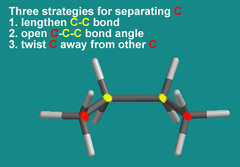The standard way to think about steric repulsion is very simple. An atom requires space for its electrons. If another atom intrudes on that space, both atoms are unhappy and the energy rises. Steric repulsion.
Unfortunately, concept doesn’t quite match reality here. It is so costly for atoms to “overlap” (unless they are bonded, of course) that they rarely do. For example the distance between the end C in butane, C-C-C-C, is practically the same in the relatively low energy gauche conformation (3.1 A) and for the very high energy “methyls eclipsed” conformation (2.9 A). (For comparison, the distance is about 3.8 A in the anti conformation.) We know that the “methyls eclipsed” conformation is destabilized by steric repulsion, but the distance between the methyl groups is still fairly large. What’s going on?
First, let me convince you that the methyl groups are tightly packed together in both the gauche and “methyls eclipsed” conformations. Tube models and space-filling models of both conformers are shown below (the tube models are offered simply to help you identify atoms in the space-filling models) and it should become obvious after some examination that the methyl carbons touch each other in both conformations. Despite this, and despite the similar distances between methyl C (3.1 vs. 2.9 A), the two conformers have vastly different energies (?E = 19 kJ/mol).
“Methyls eclipsed” butane models
So what gives? Why do we call this “steric repulsion” (or van der Waals repulsion) if the atoms don’t actually overlap? And, if the C atoms don’t overlap, what destabilizes the eclipsed conformer beyond the usual effects of torsion strain?
The answer to these questions does not lie with the (not) overlapping atoms, but with something else. Steric repulsion, it turns out, is actually caused by the molecule’s response to possible overlap. It’s kind of like the runny nose and cough that you get when you’re sick. A cold virus doesn’t actually make your nose run or make you cough. Instead, its your body’s immune response to the virus that gives you these symptoms. And that’s how it is with steric repulsion. The molecule doesn’t want to let atoms overlap in space, but to prevent this from happening, the molecule must contort itself in ways that create strain, i.e., destabilize the molecule.
You might understand this better if you look again at “methyls eclipsed” butane.
If the molecule were to adopt “standard” or “ideal” bond distances and angles in this conformation, the end C (red) would get much too close for comfort (2.55 A). So the molecule prevents this from happening by adopting some combination of the strategies listed in the figure: 1) stretching bonds, 2) open bond angles, and/or 3) twisting the red C apart. Strategy #3 is only available when we can change the conformation, so the eclipsed conformer must pursue strategies #1 and #2. Let’s see how this works.
- Stretching the yellow CC bond. The distance between the yellow C in anti butane is 1.529 A. In “methyls eclipsed” butane, the distance is longer, 1.555 A. So the molecule uses this strategy to separate the red C.
- Opening the CCC bond angles. These bond angles are 113.1 deg in anti butane, but they open up to 117.0 deg in “methyls eclipsed” butane. So the molecule uses this strategy too.
So, when we pay close attention to the entire molecular geometry (bond distances, bond angles, and torsion angles), we discover that the molecule actually distorts multiple parameters in order to keep the end C atoms from overlapping. Each distortion destabilizes the molecule, and it is the cumulative effect of these distortions that we call steric (or van der Waals) repulsion.


